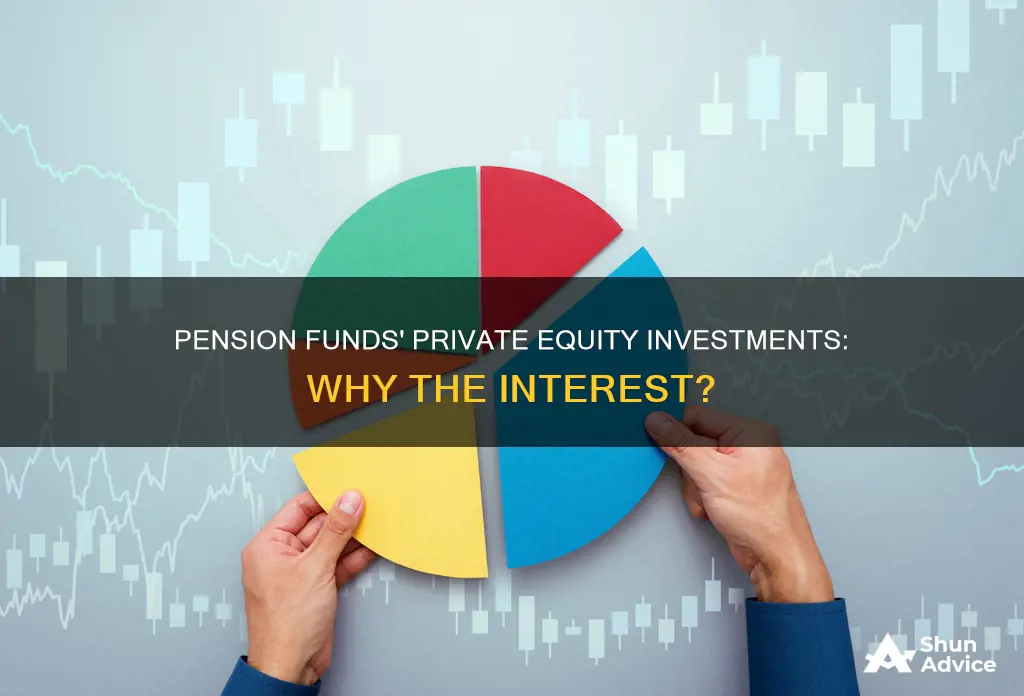
Pension funds are increasingly investing in private equity due to the allure of high returns and access to unique investments. Private equity firms offer pension systems a potential avenue to overcome the declining public market returns of the past decade, with the added benefit of diversification and reduced volatility. However, private equity investments also come with drawbacks such as high fees and a lack of transparency. Public pension funds are under pressure to reduce accumulating debt and present actual rates of return that match estimates, making the promise of high returns from private equity investments particularly attractive.
| Characteristics | Values |
|---|---|
| High returns | 12.3% median annual return over 10 years, according to the American Investment Council |
| Diversification | Private equity allows pension funds to diversify their portfolios and reduce volatility |
| Reduced volatility | Private equity can help pension funds reduce volatility |
| Risk | Private equity is considered riskier than other investments due to a lack of transparency and high fees |
| Illiquidity | Private equity investments are illiquid |
| Access to unique investments | Private equity provides access to assets not available on public markets |
| High fees | Private equity firms charge high fees for their services |
What You'll Learn

Private equity offers higher returns
Private equity has a reputation for offering higher returns than other asset classes. The American Investment Council claims that private equity provided a median annualised return of 12.3% over 10 years, with the Illinois State Board of Investment reporting a 10-year annualised return of 19.8%.
Private equity firms pitch pension funds with the promise of outperforming traditional assets, such as ExxonMobil, by investing in local businesses, such as a trash collection company. This is an attractive prospect for pension funds, as they are under pressure to reduce debt and present an actual rate of return that matches estimates.
The potential for higher returns is also what drove four of New York City's five public employee pension funds to boost their allocations to private equity. The boards of directors for the retirement funds of teachers, police officers, firefighters, and civil servants voted to increase the share of assets invested in alternative investments, including private equity, to meet their target of a 7% annual return.
Pension funds are also attracted to private equity because it provides access to unique investments that are not available on public markets. Private equity allows funds to diversify their portfolios and reduce their reliance on traditional investments such as stocks and bonds.
While private equity offers the potential for higher returns, it is important to note that it also comes with higher risks and fees. Private equity firms charge high fees for their services, and the illiquid nature of private equity investments can make it difficult for investors to access their money if needed.
Best Mutual Funds to Invest in the USA
You may want to see also

Diversification and reduced volatility
Private equity investments allow pension funds to diversify their portfolios by giving them access to assets that are not available on public markets.
Pension funds have traditionally invested in stocks and bonds, but changing market conditions and the need to maintain high rates of return have resulted in pension plan rules that allow investments in most asset classes. Private equity is one such asset class, along with real estate, infrastructure, and securities like gold that can hedge inflation.
Private equity investments provide pension funds with access to unique investments and the potential for high returns. For example, the Illinois State Board of Investment has achieved a 10-year annualized return of 19.8% on its private equity portfolio, and 16.10% according to another source.
By diversifying their portfolios and investing in private equity, pension funds can reduce their exposure to volatile public markets and improve their risk-adjusted returns. Private equity investments are typically long-term, allowing pension funds to redeploy capital continuously and balance liquidity and growth.
However, private equity investments also come with certain drawbacks, such as a lack of transparency and high fees. Critics argue that the high fees charged by private equity firms can undermine gains and transfer market and fundamental risk to pension funds.
Overall, private equity investments offer pension funds the potential for high returns and diversification but also carry certain risks and drawbacks that need to be carefully considered.
Actively Managed Funds: Where to Invest Your Money?
You may want to see also

Access to unique investments
Pension funds are increasingly investing in private equity to gain access to unique investments. Private equity offers pension funds the opportunity to invest in assets that are not available on public markets. This allows pension funds to diversify their portfolios and potentially achieve higher returns.
Private equity investments can provide access to a range of asset classes, including real estate, infrastructure, and securities like gold that can hedge against inflation. For example, pension funds may invest in commercial real estate, such as office buildings, industrial parks, or retail complexes, to create a portfolio that combines equity appreciation with a rising stream of inflation-adjusted income.
Additionally, private equity firms often invest in the equity of privately held companies, with the intention of eventually selling the investments for substantial gains. This provides pension funds with access to unique investment opportunities that may not be available through traditional public market investments.
By investing in private equity, pension funds can also take advantage of the industry's reputation for high returns. The American Investment Council, for example, claimed in its 2021 Public Pension Study that private equity provided a median annualized return of 12.3% over 10 years, outperforming other asset classes.
However, it is important to note that private equity investments also come with certain drawbacks, such as a lack of transparency and high fees. Despite these detriments, many pension funds are willing to take on the risks associated with private equity investments in their search for higher returns and access to unique investment opportunities.
Best Vanguard Index Funds to Invest $1000 Minimum
You may want to see also

Alternative investments are riskier
Private equity is an alternative investment category that is considered riskier than traditional assets. It involves investing in the equity of privately held companies, with the goal of eventually selling those investments for substantial gains. While it offers the potential for high returns, it also comes with a higher level of risk.
One of the main risks associated with private equity investments is the lack of transparency and high fees. Private equity firms charge significant fees, often including a percentage of assets and a share of the gains. These fees can eat into the returns and increase the overall risk of the investment. Additionally, private equity firms may engage in unreasonable risk-taking, which can lead to unsustainable management and misallocation of capital. This exposes pension funds and their beneficiaries to more risk than they may have anticipated.
Another risk is the illiquid nature of private equity investments. Unlike publicly traded stocks, private equity investments cannot be easily bought or sold on the market. This lack of liquidity can make it difficult for pension funds to exit an investment if it is underperforming or if they need to reallocate their assets. Private equity investments are also subject to the asymmetry of information, where private markets may not provide accurate or timely data, making it challenging for investors to make fully informed decisions.
Furthermore, the complexity and opaqueness of private equity structures can make it difficult to assess the true value of an investment. The actual rate of return on private equity investments may not be known for years or even decades, as they are not marked to market. This uncertainty adds to the overall riskiness of these alternative investments. Private equity firms may also engage in misleading marketing practices, overpromising returns or using speculative figures to attract investors.
Lastly, alternative investments, including private equity, tend to underperform over longer time horizons. A study by The Journal of Investing found that U.S. public-sector pension funds realised a negative alpha of approximately -1.2% per year, largely due to their exposure to alternative investments. This underperformance highlights the potential downside of investing in private equity, as the risks may outweigh the potential rewards over the long term.
Best Mutual Funds for One-Time Investments: Where to Invest?
You may want to see also

Private equity has high fees
Private equity funds have a fee structure similar to hedge funds, typically consisting of a management fee and a performance fee. Private equity firms usually charge annual management fees of around 2% of the committed capital of the fund. The performance fee, also known as carried interest, is usually around 20% of the profits from investments. These fees can be a turnoff for some prospective investors, especially when combined with the long investment time frame of private equity funds.
The management fee is generally charged on committed capital, meaning it is charged on the entire amount that an investor commits to a fund, regardless of whether the capital is actually drawn or invested. This can result in the firm earning substantial fees even if it fails to generate a profit for investors. For example, a $2 billion fund charging a 2% management fee would earn $40 million per year, regardless of its investment performance.
In addition to management fees, private equity funds often charge administrative fees to cover expenses such as audit, accounting, and legal services. These fees are typically not transparent and can be as high as 0.15% of fund assets. Private funds may also receive other fees from third parties related to the fund's activities, such as placement fees, directors' fees, and transaction fees.
The performance fee, or carried interest, is typically between 15% and 20% of the fund's net profit after the management fee has been deducted. In some cases, the incentive fee can be as high as 30%. This fee is intended to align the interests of the fund managers with those of the investors, as the managers only make significant money if their investors do well.
Overall, the high fees associated with private equity funds can be a significant burden, especially for smaller pension funds. These fees can undermine gains and transfer market and fundamental risk to the pension funds. Therefore, pension funds must carefully consider the potential benefits and risks of investing in private equity and ensure that the fees are appropriate for the level of risk and expected returns.
Mutual Fund Investment Guide for NRIs in India
You may want to see also
Frequently asked questions
Pension funds are increasingly investing in private equity because of the industry's reputation for high returns. Private equity investments allow pension funds to diversify their portfolios by giving them access to assets that are not available on public markets.
Private equity investments are associated with a lack of transparency and high fees. There is also a risk of underperformance, as these investments can be much riskier than they appear.
Private equity investments can provide better value for money and help pension funds meet their annual investment return goals. They can also be a good diversification strategy and reduce volatility.







